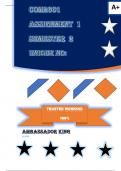A+
TRUSTED WORKING
100%
AMBASSADOR KING
ADMIN
,COM2601 Assignment 1 (COMPLETE ANSWERS)
Semester 2 2024 - DUE August 2024 ; 100% TRUSTED
Complete, trusted solutions and explanations. For
assistance, Whats-App
Question 1
1.1 Define and describe organisational culture. (8)
1.2 According to Neher (1997), Miller (2003) and Jones
(2007), members of an organisation can fulfil various
network roles. Select an organisation of choice and
identify three network roles that are present in this
organisation. Supplement your answer by providing
examples of each of these network roles. (6)
1.1 Define and Describe Organisational Culture (8)
Definition:
Organisational culture refers to the shared values, beliefs, norms, and
practices that shape the behavior and interactions of members within an
organisation. It encompasses the collective attitudes and behaviors that
define how work is performed, how employees interact with each other
and stakeholders, and how decisions are made.
Description:
, 1. Shared Values and Beliefs: At the core of organisational culture
are the values and beliefs shared by members. These often stem
from the organisation's mission, vision, and leadership, shaping the
priorities and ethical standards of the organisation. For example, a
company that values innovation will encourage creative thinking
and risk-taking.
2. Norms and Practices: Organisational culture is reflected in the
day-to-day practices and routines within the workplace. This
includes formal policies and procedures as well as informal
behaviors and traditions. For instance, an organisation that
prioritizes customer service may have a culture where employees
go above and beyond to meet customer needs.
3. Symbols and Language: Culture is also communicated through
symbols, rituals, and the specific language or jargon used within
the organisation. Logos, uniforms, ceremonies, and the
terminology used in communication all contribute to reinforcing
the organisational culture.
4. Leadership and Management Styles: The way leaders and
managers conduct themselves significantly influences the
organisational culture. Leaders set the tone for acceptable behavior
and can embody the values and ethics of the organisation. For
example, a participative leadership style may foster a culture of
collaboration and openness.
5. Communication Patterns: The manner in which information
flows within the organisation is a crucial aspect of its culture. Open
and transparent communication can foster trust and inclusivity,
whereas a top-down approach may create a hierarchical and
controlled environment.
6. Work Environment: The physical and social environment of the
workplace, including the layout of office space, work-life balance
policies, and social interactions, shapes the organisational culture.
A flexible and modern office layout might promote a culture of
innovation and collaboration.
7. Employee Engagement and Morale: Organisational culture
directly impacts employee satisfaction, engagement, and retention.




